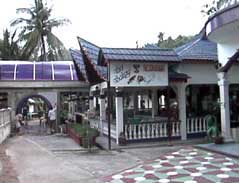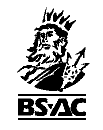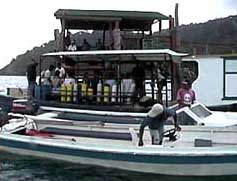

How it started? It all began with an idea from one of our graduating Sports Divers.
"Hey guys, let's go to Tioman for a check-out dive, shall we?" exclaimed the newly qualified Sports Diver, with zeal, excitement and pride on his face, after passing the Sports Diver theory test on a Thursday evening at Jalan Sultan Plaza.
"Just send us a mail, fix the dates, otherwise people only talk no action, ok?" he continued. The enthusiasm was so infectious and his request so sincere that it was too unbearable to decline. "On lah on lah, we will sent a mail" I said.
The mail was sent a few days later. A week past and then the second, the response was lukewarm. One came but was subsequently withdrawn, while others had equally valid reasons for not making it. So, the anticipated response did not materialize. For the organizers, things started to get restless when the days drew closer. "So what now? Shall we proceed? There is only one week left and we have only five people on the list!" I said in exasperation. "Relax man, don't be tense, let's send another email to confirm " replied Steven, my partner in this adventure. The response never come!
"Let's proceed with the trip, as some members already had their leaves approved, it's not good to cancel the trip at the last minute " said Steven. And so, here we are, documenting the experiences of this trip. It turned out to be a most satisfying and rewarding dive trip for all who came along. The water was pristine clear with penetrating visibility; coral and fish life were magnificent with mesmerizing abundance. Tioman Island could still offer one of the finest diving in Peninsular Malaysia. For us, it was a weekend of ultimate underwater enjoyment and escapism.
 Twenty minutes upon arrival, we were on the dive boat, heading towards our very first dive site. The series of events occurred so swiftly that the new members had little time to feel nervous (if you really do, sorry, I was too preoccupied with the scenery to notice you guys). Our first dive was made at Pulau Tulai: Fan Canyon. Pulau Tulai was located on the north-west side of Pulau Tioman, 15 minutes from Kampung Salang Jetty. The condition was calm, but became quite choppy nearer the boulder outcrops.
Twenty minutes upon arrival, we were on the dive boat, heading towards our very first dive site. The series of events occurred so swiftly that the new members had little time to feel nervous (if you really do, sorry, I was too preoccupied with the scenery to notice you guys). Our first dive was made at Pulau Tulai: Fan Canyon. Pulau Tulai was located on the north-west side of Pulau Tioman, 15 minutes from Kampung Salang Jetty. The condition was calm, but became quite choppy nearer the boulder outcrops.
Pulau Tulai looked to me as if a Mighty Being had once played dice here. After the game, he left the dice behind. Through the millennia, the dice became squarish giant boulders, scattered and stacked randomly, forming an outcrop jutting out from the sea. On the sea bed, these giant boulders were gathered and collapsed on each other, forming various geometrical shapes, creating nooks and crannies, open gap-ways and narrow tunnels where any competent and adventurous diver could venture and explore.
Within these tunnels or gap-ways, you could find brightly colored gorgonian sea fans, feather stars and stinging hydroids, carpeting the walls. It was an adrenaline flushing experience maneuvering inside the tunnels. It was dark and one could feel a bit claustrophobic, I had to move with caution relying on my torch, so as not to damage the brittle sea fans. As I inched forward, I encountered a school of shining gobies swimming through, intuitively breaking into two separate trajectories in front of me and merging again with clock-like synchronism behind me. There were also other small fishes taking shelter in the tunnels, possibly from the predating giant groupers outside.
On the open sea-floor, there were many species of huge sea cucumbers, not those found in Pulau Hantu. These were big, about the size of an adult arm and came in wide variety of colors. Beside, there were also sea stars, cushion stars and other species of enchinoderms. My first dive lasted for 50 minutes and was logged with a maximum depth of 22 metres.
The sandy bottom at Batu Malang was covered with boulders, soft corals, anemones and their attendant clownfishes. To impress us, our dive guide caught a little clown fish and put it inside his mask. While the frightened little clown fish was swimming inside his mask, he kept signaling the OK sign. May be, times were bad for diving too, for him to have to resort to such antics. As we cruised above the sandy sea bed, we came across sporadically placed boulders. At these boulders, there would always be a group of resident black fishes, hiding in the staghorn corals growing around. I could not identify these black fishes. They bore a strong resemblance to the clownfishes but they were pitch black in color and had no stripes. These small fishes were as curious and mischevious about us as we were about them. From afar, we could see them roaming nonchalantly around the boulder. As we approached, they would turn and look in our direction before quickly taking refuge in the crannies between the staghorns. As we passed, they would emerge from their hidings again to watch us go.
Down on the sand, there were blue spotted rays, a wide variety of solitary sea cucumbers, sea stars and cushion stars. There were also clusters of sea urchins, probably having conferences, and not far away there would usually be a lone urchin, usually a big one. "That is the king urchin, he is giving a sermon to his subjects" said Faizal, the guide, after the dive. There were also gobies and I came across an adolescent leopard shark hiding under an overhang. The second dive lasted 45 minutes with maximum depth of 12 metres.
For myself and David, we spent the evening with Asmi, a senior Padi Master Instructor Trainer. He had a wealth of diving experience to tell and he had had a wide variety of students too. "There was this young student, fit, tough and an open water diver, who came to take up advanced open water course from me" recalled Asmi. "How could you withstand the pain when we were underwater, my ear was so painful and I really wonder how you do it?" the student asked. Asmi was really shocked, he could not imagine that all the while the student was enduring the pain while he was teaching him underwater. "I can't imagine how this guy could stand for so long without clearing his ear, and he was an open water diver" said Asmi. Our jaws dropped. After a couple of beers, the stories flowed freely and we stayed up till about 1 a.m. before heading back to our beds.

We stopped at the north-eastern corner of Pulau Chebeh. Below the surface, huge volcanic boulders tumbled down to the flat sandy bottom. There was an exuberant growth of soft coral on these boulders. As I descended, I had the temptation to sit on one of these boulders with my legs hanging in mid-water; but, I could not find sitting space, as the surface of these boulders were too densely populated with soft corals.
When all of us descended, we regrouped, and followed our dive guide linearly. He brought us in, around and through openings and valleys between the large volcanic boulders. Suddenly, we had a better appreciation of three dimensional space. We were very used to navigating on the two dimensional plain. Navigation in the three dimensional space gave us an enchanting and relaxing experience. At least, the force of gravity could be felt lesser, we could learn to fly...
A prominent resident of Pulau Chebeh is a pair of clown trigger. They were very suspicious of divers and had attacked ignorant divers in the past "Bob, never under estimate the force of this fish, can you see here, these are nips from the fish, when you got hit, it's like being hit by an iron pole in the head, no joke man" said our dive guide earlier, proudly showing us the scars that creased his forehead. Knowing this, we kept a distance away from the trigger. Beside the trigger, there were many blue-spotted lagoon rays. They could be found on the bottom of the sea-bed or under the boulders.
The total dive time was 47 minutes and maximum depth was 25.3 metres.
Then, when everyone was back at the boat, as we began to dekit and stow away our gears, we had uninvited guests. David was the first to spot a family of dolphins on the surface. We were excited and our boat headed towards them. Our dive guide began to bang on the side of our boat in regular beat and this attracted the dolphins.
They swam in front of the boat at the bow. This was the first time I saw dolphins leaping into the air in the open sea. Do I sound like watching a documentary by the late Jacques Cousteau? Nevetheless, the dolphins' aerodynamically shaped bodies had made them exceptionally good swimmer. It was a pity we were on the surface, otherwise we would have an entirely different experience.
We arrived at Salang Jetty around 2.30 p.m. Then, we proceeded to dekit, rinse and stow away our dive gears for the night dive. When we had lunch, it was about 3.15 p.m. We went to the same Chinese restaurant we ate the day before, and most of us ordered fried rice. It was good, we need a lot of carbohydrate to replenish our energy after the dives.
The weather was hot after our lunch. Most of us took an afternoon nap in our air-conditioned accommodation. While others began to log their dives. I woke up around 6 p.m., we were scheduled to gather at 7 p.m. at the dive shop.
For our group of five, three of us were doing it the first time. For Steven Ng and myself, this was not our first, instead this was our third night dive. Nevertheless, I could still feel the anxiety. "Hey Faizal, three of my group are doing it the first time, so go slow ok? For Lily, she told me that she was afraid of darkness, so she will stick with you in front, and we will go behind you. ok?" I said to our dive guide. "No problem, just relax ok?" said Faizal. "Ok!" I replied.
Beside Lily, Shane and David were also doing their first night dive. To me, Shane and David looked more at ease. We kit up at the dive shop, listened to the pre-dive briefing and in full kit, we trod towards the boat which was waiting near the jetty. It was about five minutes by boat from the jetty to Pulau Soyak. Everywhere was dark, the sea was dark except the lights from the moon and our boat. At that moment, we had yet to develop night vision.
Pulau Soyak is a boulder outcrop from the sea. It is a small island with a few trees. The dive plan was to circle around this boulder outcrop, if not, at least part of it. The wave was mild and current slack, the night sky was clear. As our eyes began to accustom to the surrounding darkness, we began to see more and the beauty of things at night began to reveal itself gradually.
It was about 8 p.m. when we did a backward roll from the boat and plunged into the darkness of the sea beneath. Lily went in front with our dive guide, while the remaining four of us stayed at the back. We proceeded to explore the marine life at night.
The visibility was good, about the range of the torch - seven metres. There were many sleeping reef fishes, occasionally we would spot a few big ones such as parrot fish, napoleon wrasse and even groupers. Along the sea bed and among the corals, we could see basket stars, feather stars, crabs, shrimps and shellfish. We spotted a cuttlefish and reached out with our hands to feel it, he seemed to like our touch and refused to leave. But, I think, probably it was confused by our lights.
Then, all of a sudden, everyone began to peer under a congregation of staghorn corals. "What's happening?" I thought. As I hovered above the staghorns I could see a giant snake wiggling its body and staring menacingly towards the light sources from the divers. It must be about one metre in length, its head was about the size for an adult fist. It was a moray eel. "What an eel, I have never seen such a big eel before," said Shane later on.
As we cruised along at mid-water, at a depth of about ten metres, Faizal made a dodge. I thought he must be avoiding a squid, but then he waved the torch frantically at two shadowy shapes that were fast approaching us. "Oh boy! It looked like two black-tips feeding on squids and were coming at us," I gasped. Apparently, they were attracted by the squids and nocturnal fishes that came out during this time of the night. "Never shine your light at the fishes, how do you feel if I shine the light at your eyes?" said Faizal during pre-dive briefings, now he was shining his torch at the approaching sharks. The sharks picked up our movements, turned and disappeared into the dark water beyond. My breathing returned to normal and happily we continued our dive, as if nothing had happened.
The night dive ended at about 8.45 p.m. In my log book, it was recorded as fifty minutes dive time and maximum depth of 15 metres. From the thrilled conversations and occasional exchange of jokes after the dive, I knew that all of us enjoyed the night dive. At the surface, we also showed Lily, Shane and David what was said at the lectures. "At night, even with the torch off, you could still see underwater. There were lights reflected from the moon. As you stroke the sea water, it began to glow and gives off a display of phosphorescence". They saw it and were amused.
